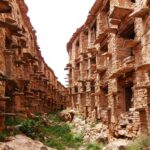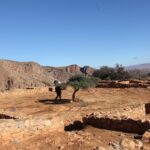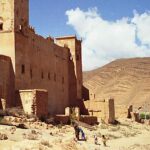Situated within the core of Tiznit, Kasbah Aghennaj is an extraordinary cultural site that covers a total area of 6704 square meters. This majestic castle, which identifies with its grand five watchtowers, shows glistening architectural inventiveness and cultural beauty. Originally, it was built for military purposes, but with time, it’s exceeded its martial roots and became the identity for Moroccan architecture and culture, and now it’s working as a heritage museum, which is a unique example of the rich culture. The interactive center is open to guests to go through its large collection that lays out its long history and the development of the region. Preserved as a true peek into the past, Kasbah Aghennaj is a perfect destination both for travelers who are passionate about history as well as for those who just would like to take a glimpse at the past.
Fortress of Waters: The Strategic Genesis of Kasbah Aghennaj
The legacy of Kasbah Aghennaj is viewed as an inseparable part of Al Hahi Mohammed Aghnaj’s, a Caid who played an important role in shaping southern Morocco’s history. In this order issued by Sultan Moulay Slimane, the military campaign launched beyond the Oued Massa in 1810 that is under me will exploit Tiznit as a strategic military base. In the year 1820, having appreciated that a strong defensive base was necessary, he built the fortress at the Blue Spring so he could always secure access to water. Hence, the positioning of the castle had the dual effect of reinforcing the territories while also establishing Tiknas as a town of paramount strategic importance, serving as the key point for the Royal Domain’s expansion.
Architectural Splendor and Strategic Design
The plan of Kasbah Aghennaj manifests the military expertise of Morocco. These imposing watchtowers, positioned to cover the big areas, were not only for monitoring the territory but also offered defense in uncertain times. Moreover, the strategic plan for the building of the fort was thoughtfully designed to address the defensive requirements specific to the era, which characterized a combination of security and efficiency. In addition, the Kasbah was strategically positioned next to the source of water to ensure a constant flow of water among its garrison for survival.
From Fortress to Museum: A Cultural Journey
The Kasbah Aghennaj serves as the historical museum of Tiznit, so people could go back in time to learn about the history of the region. The museum’s rich displays illustrate the region’s transformation from a mainly Berber area into a strategic position for reinforcing Morocco’s southern defenses. Here, various exhibits and artifacts all capture the reality of the people’s daily lives, cultural practices, and significant historical events that have shaped Tiznit and its surroundings. Indeed, this conversion of the Kasbah into a museum does not only keep its reputation but also educates and awes by linking guests to the multitude of historical events that took place there.
Why You Should Visit the Kasbah
The visit to Kasbah Aghennaj is full of historical facts and cultural experiences, as well as being very timely. Visitors have the opportunity to discover such collections as Berber jewels, original weapons, and documents referring to the Moroccan history rendered by each piece. The nearby Blue Springs makes the place even more pleasant, and after tourists have been to the museum, they can enjoy the silence by contemplating in this area. This Kasbah is best for history lovers, architectural admirers, and curious travelers because it features modern 19th-century military stratification, architectural innovations, and Moroccan cultural heritage.
















































